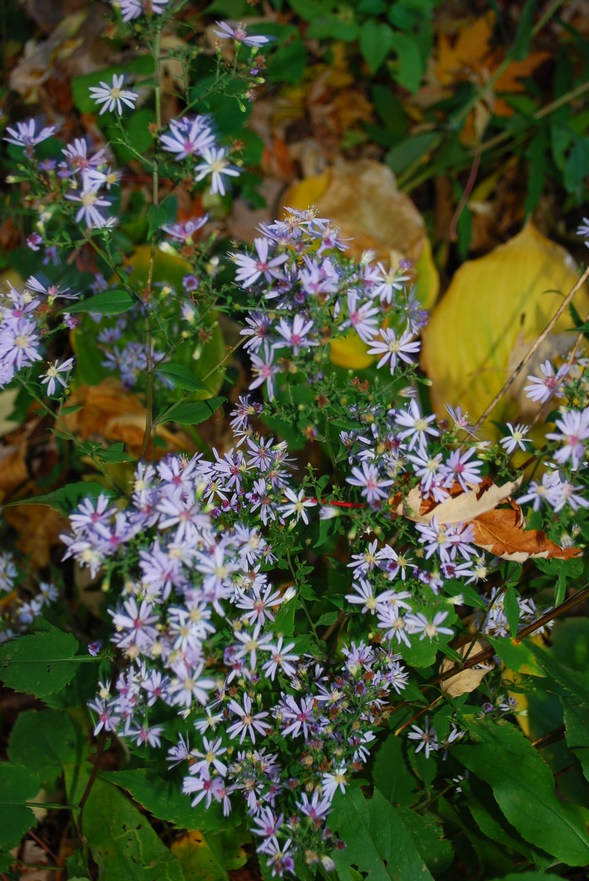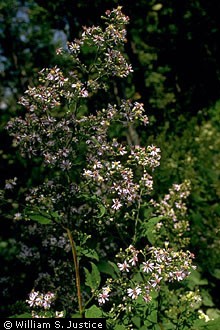Ann Arbor Native: Asters, one more time!

Heartleaf aster (Symphyotrichum cordifolium) just keeps on blooming!
Rick Meader|Contributor
I know we’ve hit on asters a couple of times this fall, but the appreciation I have for the late, ongoing color they provide makes me want to sing praises to them one more time. While most of the rest of my native (and non-native) plantings have given up the ghost of blooming and are looking a bit tired, my asters continue to stand tall and bloom, big-time.
The previous two entries talked about sun-loving asters - Smooth Aster (Symphyotrichum laeve) and New England Aster (Symphyotrichum novae-angliae), but today we’ll talk about two other asters, who, while not turning their nose at the sun, do find more shady situations a bit more to their liking. These friendly flowers are Heartleaf aster (Symphyotrichum cordifolium) and Arrow-leaved aster (Symphyotrichum urophyllum).
Really, in my yard, the biggest difference between these two plants is the leaves. Both are plants that, when flowering reach about two and a half feet tall. Neither of the plants have a lot of bulk, but what they lack in stature or girth, they more than make up for with a strong floral display.
The leaves are different in that the heart-leaved aster’s lower leaves are more, well, heart-shaped and the arrow-leaf aster is not. The heart-leaf aster’s leaves are broad at the base (about one and a half to two inches or so) and narrow at the tip of the three-inch-long leaf while the arrow-leaf aster is much narrower at the base, has winged petioles (leaf stalk) and is, well, arrowhead (really more spear-head) shaped.
The flowerheads of both have light blue to lavender (sometimes white) ray flowers (the flowers around the outside of the flowerhead) and the disk flowers at the center are cream-colored to yellow, and change to darker colors as they age. They are about half an inch to three-quarters-inch wide. The heart-leaf asters flowers are in a terminal cluster at the top of the stem, while the arrowleaf aster blooms are on the ends of upswept branches. Both of these plants are readily available from local native plant vendors, and make an outstanding late-season addition to any garden for their color, without dominating your yard before they bloom.

Arrowleaf aster (Symphyotrichum urophyllum) also packs a blooming punch.
Photo by William S. Justice @ USDA-NRCS PLANTS Database
As with the previously discussed asters, both of these flowers are native to and widespread across most of eastern North America. Since we’ve talked about asters before, the usual chatter about Native American uses of the plant has already been done to death, so let’s talk about some things you may not have known about them, thanks to an interesting website named 20-20 site.org (http://www.2020site.org/fun-facts/Fun-Facts-About-Flowers.html). Did you know that “Ancient civilizations believed that the smell of burning Aster leaves provided protection and drove malicious serpents into hiding”? Did you know that (according to encyclopedia.com, the Aster family (Asteraceae or Compositae) is widely distributed worldwide, has perhaps 1,150 genera and 25,000 species. Among those are asters, sunflowers, chrysanthemums, chicory, lettuce and safflower.
As flowers disappear, we’ll be moving up the canopy in upcoming entries, talking more about woody plants like shrubs and trees that you can still find as the leaves disappear (witch-hazel is still in bloom). We’ll even talk about some other native plant topics not directly related to any particular species. And, sooner than you know it, skunk cabbage will start the whole growing season again.
I’d love to give you a big list of plants that are still blooming in my yard, but I’m pretty much down to the asters -- Heartleaf and Arrow-leaf. But, the wild geranium is changing to a nice red! Get out and enjoy nature everyone! The biting bugs are gone!
Rick is a local landscape architect with a special interest in all things natural, including native plants and the critters that eat them. You can contact him at yourland1824@gmail.com.

